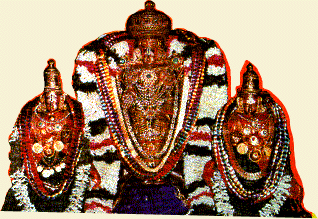

|
|
|
 |
Brahmotsavam of Lord Venkateswara is the most glittering festival in the temple of Lord Venkateswara, the Lord of seven hills. The epithet Brahma itself signifies its grandeur and, rightly so, it draws multitudes of pilgrims from all over the country, transforming in the process the picturesque hill into a Kaliyuga Vaikuntha - a heaven on the earth. According to legends, when Goddess Lakshmi left Srivaikuntham in a huff unable to bear the insult of sage bhrigu kicking Lord Vishnu, her spouse, on his chest, which she considered her abode. The Lord unable bear the solitude, began searching for her. He wandered across hills and woods until he came across the beautiful Seshachala hills, now called the Tirumala hills. Finding the place salubrious and serene, he settled down in an anthill and has been worshiped there, ever since as Lord Venkateswara. Lord Brahma , the supreme creator, commemorated the Lord Venkateswara's manifestation on earth with a grand celebration lasting 9 days and hence the name BRAHMOTSAVAM. According to Varaha puranam ,the Brahmotsavam is performed in the month of Asweeja(Salivahana Calendar),when sun is in kanya rasi. It is September-October as per English calendar. |
|
Preparatory to the festival, the interiors of the
sanctum sanctorum and the small shrines around are cleaned and smeared
with a rich paste made of sandalwood refined camphor, saffron and other
spices. This ritual is known as Koil Alwar Thirumanjanam. It is followed
by another ritual viz. Mritsangrahanam - the process of collecting earth-
and this is done a day before the first day of the festival.The ritual
signifies a prayer by the temple officials to the deities like Garuda,
Sudarshana, Anantham and Vishavaksena to seek their help for the successful
conduct of the Brahmotsavam. They also pray to the Bhooma Devi(mother earth)
and collect a small quantity of the earth with which the Ankurarpanam
ritual conducted by sowing nine kinds of cereals in it. Then
Dhwajarohanam is performed signaling the start of the grand fete.
The high priest of the temple hoists the flag carrying the picture of Garuda
atop the Dhwajasthambham erected opposite the sanctum sanctorum.
Every day during the Festival
both in the mornings and the evening the processional deity of Lord Venkateswara
called Malayyapan Swamy, is taken in a colorful procession through the
decorated four streets around the temple. The lords is flanked by his two
consorts ,Sri Devi and Bhu Devi. Ugra Srinivasa and Koluvu Srinivasa (Durbar
Srinivasa) are the two other images in the santum.All through the nine
days the hill wears a colorful look with a sea of humanity thronging
the place. The hill especially looks colorful during the night when giant
profiles of the lord, made out of tiny electric bulbs light up. The Lord
is taken in a procession on various vahanas and each vahana has its own
significance and conveys his message in its own way. The garuda seva performed on the night of the 5th day is the most popular amongst his devotees for on that day the lord is adorned with his most choicest and precious of his ornaments .Another equally important festival during the 9-day celebration is the Theru when the deities would be seated in a exquisitely carved huge wooden chariot and pulled round the temple by ardent devotees. Snapnam tirumanajanm , the process of bathing thee Lord with herbal water after the procession ,is performed to relieve him of the strains suffered during the processions . The penultimate festival is the Chakrasnanam, which is akin to the bathing ritual after the performance of a yagna. On that morning the lord and his consorts and Sri Sudarshana Chakram are given a holy bath in the temple tank after an hour long ritual on the banks of the Pushkarini, the Temple tank. Scores of pilgrims waiting on the banks of the tank would also take a dip simultaneously along with the deities, creating a huge splash. This holy dip is supposed to free a mortal from the cycle of rebirth. On the 9th day of the Brahmotsavam,chooranabhishekamis performed giving the deities a holy bath after anointing them with sandalwood powder .The Lord is then taken around in a procession when the priests distribute the sandalwood powder used for the ritual to the devotees en route. On this last day of Brahmotsavam, Devatodwasanam, the ritual of giving a warm send off to all Gods and rishis on their way back to heaven, is performed. In this ritual Lord Brahma is propitiated for having come to earth all the way from Brahmaloka and having performed the Brahmotsavam. The celestial celebration is one of the important festivals of the temple. Pilgrims from all over the world, throng the place during this to have a glimpse of the lord during the procession. The sight of the Lord himself coming out of the Temple to be amongst his devotees is awe-inspiring. |
 |